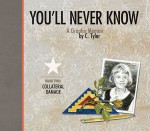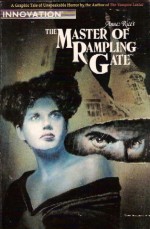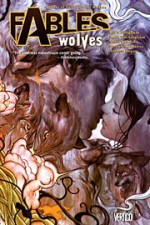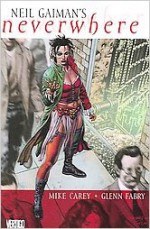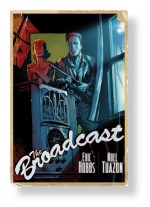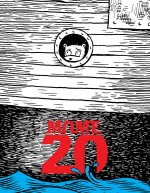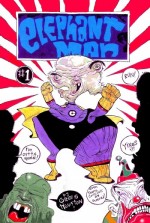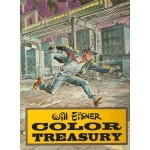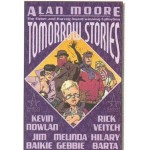
By Alan Moore & various (America’s Best Comics)
ISBN: 978-1-56389-985-0 and 978-1-4012-0166-1
Alan Moore revolutionised American Comics with a series of stunningly well-crafted series and shorter stories featuring characters created by others and in the late 1990s began working for Jim Lee’s Wildstorm outfit. Initially writing for the imprint’s reductive and post-modern line of superheroes (see Alan Moore’s Complete WildC.A.T.s and Alan Moore: Wild Worlds) he gradually began constructing his own universe, loosely based on a number of perennial concepts, genre archetypes and the visual likenesses of some Golden-Age characters long unused – and unclaimed – by copyright farmers…
In 1999 he deftly injected some fun back into a medium plagued and overwhelmed by grim tales of assorted vengeances and mind-numbing violence. The stories also found room to intellectually challenge as well as play with the readership. Moore and a selection of his very talented friends employed all the vast benefits of a shared continuity without getting bogged down in histrionics and shallow bombast, producing a line of clever, witty, beautifully illustrated adventures aimed at those adults grown from the Baby-boomers who had fed the Silver-Age comics revolution and only to be somehow deprived of their fundamental fascination by an industry increasingly devoted to fads and short-term profits.
The most perfect example of this erudite graphic philosophy was undoubtedly Tomorrow Stories, a series designed as a themed anthology title and the greater part of which has been collected in two splendidly whacky volumes of action, suspense, adventure, mystery and imagination.
Volume one, fully scripted throughout by Moore, led with the introduction of Jack B. Quick – Boy Inventor illustrated by the incredibly talented Kevin Nowlan who introduced a junior Edison in ‘Smalltown Stardom.’ The juvenile super-genius, resident on a farm in rural Queerwater Creek, rashly created a miniature sun in the back pasture and had to deal with the diminutive solar system that develops – causing traffic chaos and concomitant conniptions amongst the townsfolk and livestock…
Blending cutting edge science with wondrous surreality this feature always concealed an uplifting laugh amongst its conceptually challenging wonders…
Rick Veitch illustrated Greyshirt (a fulsome tribute to Will Eisner’s urbane detective the Spirit) and the feature began here with ‘Amnesia’ a tale of stylish murder whilst Jim Baikie slipped comfortably into broad parody and biting satire with the patriotic wonders The First American and U.S.Angel; battling Nazis, aliens and daytime television audiences in ‘Dumbsday!’
The first issue closed with ‘The Cobweb’ an exotic pastiche of such (scantily) costumed Golden-Age mystery women as Phantom Lady and Tarpe Mills’ Miss Fury in a plethora of artistic styles provided by Melinda Gebbie. This crusading feminist Lady of the Night starred in a thought-provokingly whimsical yet sinister tale of scandalous delights and forbidden horrors wherein the Amorous Avenger battled a mad scientist who literally turned women into toys and playthings…
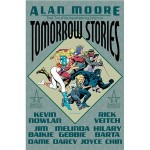
Issue #2 opened with Greyshirt in a visually arresting generational yarn of four stories in a building’s life. ‘How Things Work Out’ (illustrated by Veitch) played with Time, Space and vertical altitude to define how crime affects people over the course of decades whilst physics got another well-honed kicking from Jack B. Quick in ‘The Unbearableness of Being Light’ as the brainy boy determined that photons in Queerwater had been over-imbibing intoxicants…
It was ‘Waltztime’ for Cobweb when she encountered dancing alien phantoms in the asteroid belt whilst the First American crushed a backwards-looking felon wielding a deadly Nostalgitator in ‘The Curse of the Reverse!’ to close the proceedings.
Quick’s ‘Pet Theory’ is a triumph of bad-taste: an animal-testing black comedy that tips a cocky hat to Orwell’s Animal Farm; the ever experimental Moore & Gebbie pulled off an illustrated prose thriller-tragedy in the Cobweb fragment ‘Eurydice: A Retrospective’ and First American took a painful look at youth culture and juvenile crime in ‘The Peril of the Pediatric Perpetrators’ before the smoke-coloured man of mystery once more stole the show in ‘The Making of Greyshirt’: a different kind of origin from Moore & Veitch.
The President Clinton/Ken Starr clash got a jovial shout-out in #4’s First American micro-saga as ‘The Bitter Crumbs of Defeat!?!’ almost saw the Patriotic Poltroon investigated and legislated out of business whilst ‘Li’l Cobweb’ married the innocent charms of childhood with a more sordid look at modern relationships and ‘Tempus Fugitive’ pitted Greyshirt against a conceptually inept time-bandit, after which Jack B. Quick hilariously, confoundingly also got the chronal itch as he underwent ‘A Quick Geography of Time’.
Musical explorer ‘Dr. Crescendo!’ paid an ultimate price for his virtuosity in the Greyshirt tale that opened issue #5 whilst Cobweb slipped into moody old territory with the fabulous old Romance fragment ‘La Toile dans le Chateau des Larmes’ a gothic triumph hinting at the true vintage of the spidery siren and first American got in the festive spirit just in time for ‘A Christmas Cop-Out’.
The premiere volume closed with #6 and a Greyshirt saga entitled ‘Day Release’ wherein the supernatural supplanted the grimly urban blight of crime and First American manfully resisted any urge to get all “Touchy-Feely†in the impressively brusque ‘Lo! There Shall Come a Closeness and Commitment!’ with the ever-ambivalent U.S.Angel dragged along for the ride, after which Cobweb found herself distressingly confined with an arachnid opponent who left her ‘Shackled in Silk!’
The final tale is a debut, as an old champion awakened to a world that had pretty much outgrown him. Inky Idol Splash Brannigan: Indelible Avenger made a long-overdue first reappearance in ‘The Return of the Remarkable Rivulet!’ by Moore and Hilary Barta, wherein a downtrodden comics artist accidentally freed an ebullient liquid asset to fight crime and crush her intolerable deadlines…
The hardcover tome under review here also includes all the covers, a selection of sketches and artwork by Nowlan, Veitch, Gebbie and Barta and a copious informative biographies section.
The second volume (reprinting issues #7-12) was also fully written by Moore and riotously opened with the Barta limned Splash Brannigan romp ‘A Bigger Splash!’ as the Dark Stain and Miss Daisy Screensaver stumbled into the atrocity of the modern art market, after which Melinda Gebbie revealed the Maid of Mysteries’ flower-power experiences in the trippy flashback ‘Grooveweb’ and First American selectively recalled recent history from an ideal perspective in ‘The 20th Century: My Struggle’ before Veitch again stole the show with the compulsive Greyshirt thriller ‘How’s My Driving?’
First American muffed the chance to tell his story as a docu-soap in the biting ‘Justice in Tights!’, that Brannigan chap endured horror beyond description when he attended a comics convention and battled ‘Testostor the Terrible!’, Cobweb fans got a rare treat with the uncovering of rare (and faux) newspaper strips featuring her and bosom buddy Clarice clashing with a lost tribe of jungle women, and Greyshirt’s ever-varying cast examined their own interior monologues in the innovative ‘Thinx’.
Alternative Comics darling Dame Darcy illustrated Cobweb’s hardboiled fairytale detective yarn ‘Farewell, My Lullabye’, but series regular Jim Baikie stayed the course to mistreat us to ‘The Origin of the First American’ and Rick Veitch went for the gusto in the show-stopping ‘Greyshirt: The Musical!’ before Splash Brannigan ended the issue with a heartfelt parody parable in ‘Splash of Two Worlds!’
Jack B. Quick triumphantly returned in #10 to solve the mystery of Manure Circles in an alien extravaganza of bovine bombast ‘Why the Long Face?’, ably complimented by the fast-paced Greyshirt thriller ‘…For a Blue Lady’ whilst First American was inaugurated for his ultimate role in the uproarious ‘What We Probably Inhaled at the Toilet’s Last Cleaning!’ and Dame Darcy again enthralled in the quirky travelogue ‘Cobweb of the Future!’.
Splash Brannigan left an inky residue on the pristine world of Pop music in ‘Splash City Rocker!’, Greyshirt went all monster-hunter in the cleverly crafted ‘Vermin’ and we had a behind-the-scenes glimpse of super-patriotic life in ‘Being the First American’ before Joyce Chin illustrated the eerie Cobweb period-piece ‘Bedsheets & Brimstone!’.
This volume and the original series concluded with #12 (although a couple of Specials were later released) so Moore and Veitch celebrated the wind-up in grand style with a Greyshirt/Cobweb team-up ‘Strands of Desire’ wherein the Sultry Sleuth and Man of Smoke and Mirrors set out to catch the sinister, sexy Moneyspider, concluding in the evocative ‘Shades of Grey’ after which Jack B. Quick took one last chance to shock and amaze with the hilariously straight-faced vignette ‘The Facts of Life!!’, leaving the Flag-Draped Fool to close the comics experimentation with an audacious homage to the breadth of comics imagination in ‘The Death/Marriage/Son of the First American of the Future!’ neatly revering and skewering it and ourselves in one swell foop.
Bold, insightful, witty and not at all precious Tomorrow Stories was a brave attempt at being fresh with archetypes whilst asking audiences to respond with brain as well as gut. Comics fans alternatively love it, hate or don’t get it: I really hope you get it (them, they, whatever…)
© 1999, 2000, 2001, 2002, 2004 America’s Best Comics, LLC. All rights reserved.
